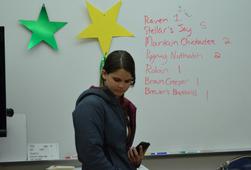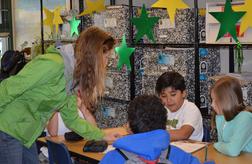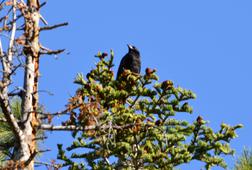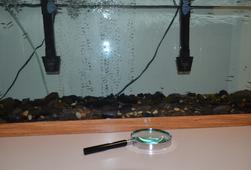saveourplanetearth.com
Call us: (775) 831-1331
Spring Birding Club, Incline Village Elementary
Incline Elementary Birding Club, conducted by the Tahoe Institute for Natural Science (TINS), wrapped up its spring session last week, which I was lucky enough to attend, observe and learn.
The first week at the beginning of May, the club decided to adopt the Audubon’s warbler, also known as the yellow-rumped warbler, as the focus of study for the spring classes.
They spent the next few weeks learning more about the warbler: its eating habits, migration patterns, learning about elements necessary for a successful habitat; then spent the last day conducting a habitat survey.
Across the street we went to Rosewood Creek, complete with a stream, a couple of bridges and plenty of trees.
The first bird we heard was what we thought to be an American robin; however, upon further study, we determined it to be a black-headed grosbeak. The grosbeak and the robin sound very similar but there are some clues to listen for when you can’t make sight of the bird.
The robin’s song is slightly deeper, the grosbeak’s a tad more musical. I listen for the “hoo-hoo” that is present in the song of the grosbeak. To really study the differences, an excellent source is the Cornell Lab of Ornithology’s allaboutbirds.org/guide.
Listen to the songs of many birds on the site and while you’re comparing the robin to the grosbeak, have a listen to the Western tanager, because the tanager sounds much like these two.
One thing we decided today, it takes a lot of study to be able to ascertain the difference between the many bird songs. When first beginning to learn, the songs ALL sound similar but over time, you will be able to begin to tell the difference.
As we entered the woods across the street, we heard the song of a bird I’ve been trying to identify for two years. And then we saw him! Our able guide, Amy Gondran, an AmeriCorps volunteer with TINS, quickly identified the small bird with the curved bill as the brown creeper.
The creeper, also known as the American tree creeper, measures about five inches and weighs less than half an ounce. He’s buff-colored on his belly, brown streaked on his back, blending in extremely well with the bark he creeps along, scooping out bugs with his de-curved bill.
Amy has been an AmeriCorps volunteer for the past year, working at TINS in its various nature programs. Her servitude is about to pay off as she recently learned she has been accepted to a fully-funded graduate program at Virginia Tech to study forest hydrology and water management.
While I was marveling over the brown creeper, the children were busily collecting data, supervised by Olivia Cushing, Science & Outdoor Education Coordinator, Incline Elementary.
Olivia is passionate about science and inspiring young people to want to learn more about the environment we live in.
The first thing I saw when entering the science lab was a fish tank with small, narrow fish I had not seen before in a tank and I learned they were baby Lahontan cutthroat trout, being bred there by special permit from the Nevada Department of Wildlife, for eventual release into Lake Tahoe.
After our 30 minute field study spent observing and documenting, we were back in the lab tabulating results.
In addition to the brown creeper and the grosbeak, we saw mountain chickadees, Steller’s jays, a raven, one Brewer’s blackbird and two pygmy nuthatches.
As well as counting birds when conducting a habitat survey, the children were also determining if there were food, shelter and space available, and checking for trash.
A simple point system displayed that the habitat we surveyed was indeed prime habitat for the adopted bird, the Audubon’s warbler, and the habitat was given a score of 110, 75-100 points being excellent habitat.
I learned more in this hour spent with this group of young people and their knowledgeable leaders than I do in several on my own out in the field. Truly, teachers such as these are some of the most important people in our society, responsible for stimulating the natural learning ability and curiosity of the upcoming generation.
Thank you, Birding Club, for another enjoyable experience out in the field. And for showing me the brown creeper!
The birding club spots a brown creeper.
Back in the classroom, club members enter data collected into the habitat survey.
Tabulating results from the field study.
This raven was spotted by club members, and was being dive-bombed by Steller's jays.
The classroom fish tank, containing baby Lahontan cutthroat trout.






